How to do bench press?
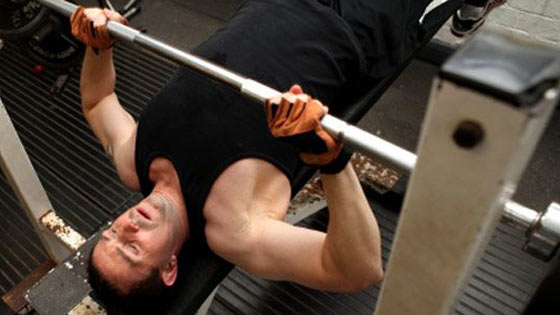
The bench press , or bench press , is one of the most practiced movements in weight rooms. For most practitioners, this is the king movement to strengthen the pectorals, and it is often with this exercise that we start the week. To the point that some people joke: “ Monday is pectorals!” » Because yes, Monday is International Pectoral Day... It's indeed difficult to find a free bench press bench on a Monday! The reason ? We always start with what we like the most…
The bench press is also one of the movements that allows you to evaluate the muscular strength of the upper limbs. It is also used in athletic strength tests with the squat and the deadlift.
 This chest strength exercise is a core movement that helps build muscle mass and build upper body strength. It involves two joints (elbow and shoulder) and actually allows you to work the entire torso, not just the chest. It is therefore wise to include it in your pectoral strength training program.
This chest strength exercise is a core movement that helps build muscle mass and build upper body strength. It involves two joints (elbow and shoulder) and actually allows you to work the entire torso, not just the chest. It is therefore wise to include it in your pectoral strength training program.
For it to be effective, you must have good execution technique because the movement is more complex than it seems. This exercise can be difficult to master for beginners who often lack strength and coordination. It's probably best to do push-ups or use machines before starting to bench press when you're starting out.
How to do bench press correctly? What are the mistakes to avoid and the precautions to take? What are the different variations? All the answers to your questions below.
What muscles work the bench press?
The bench press works the muscles of the trunk, mainly the pectoralis major and minor, the anterior deltoid, the triceps. Other muscles come into play depending on how you perform the exercise, position yourself and maintain balance, such as the latissimus dorsi, serratus major, camisole arm muscle, glutes, lumbar and abdominal muscles.

It's true that the pectorals do most of the work during the exercise, but the shoulder muscles also play an important role in moving the load and stabilizing the movement. The triceps also intervene to straighten and lock the arms.
By changing the inclination of the bench, the hand spacing or the amplitude, you can focus on different parts of the torso. The flat bench press with a narrow grip works the triceps more. The decline bench targets the lower pecs and seems gentler on the shoulders and back. As for the inclined bench press, it is the upper pectorals and the shoulder muscles that take precedence. You can also use dumbbells instead of the barbell. This variation of the dumbbell bench press allows greater amplitude and uses your stabilizing muscles even more.
In short, there is not a bench press but bench presses. In addition, the morphological aspect and sensations must be taken into account because not everyone is “made” for this exercise. If you don't do pectorals, the bench press doesn't bring you the expected results or it causes pain, don't waste your time on this exercise, however popular it may be. Because yes, in bodybuilding there are no essential exercises! Conversely, if the exercise benefits your pectorals and everything is going well, continue!
How to do bench press correctly?
How to do a good bench press? That’s a good question! Follow the steps below to do the bench press safely.
- In the starting position, you lie on the bench press bench. The bar placed on the supports is at eye level.
- Place your hands pronated on the bar, slightly more than shoulder-width apart. Feet are placed flat on the ground for greater balance.
- Unhook the bar from the supports and hold it with your arms outstretched. It is then located at the top of the pectorals. Your shoulder blades are pulled back and down to “unload” the shoulders. Keep the chest “out”.
- While inhaling, lower the load slowly until it touches the pectorals (nipples). The elbows form an angle of approximately 45 degrees with the body. The amplitude can be limited in the low position depending on the body shape.
- Expand the load by pushing to the top position. The movement is not strictly vertical, but in an arc. We are not pushing straight!
- Return to the initial position and exhale.
- Chain the repetitions of your series, always slowing down the descent.
- At the end of the series, place the bar gently on the supports. A partner's help can be helpful both when removing the bar from the rack and when putting it back down – or to help you if you get stuck.
Breathing
Inhale as you lower the bar and exhale as you return to the starting position. It is not recommended to hold your breathing during exercise. However, this maneuver helps stabilize the torso and provides a solid base for the shoulder and chest muscles. If you are using heavy weights, exhale after passing the delicate point.
Tips for performing the bench press correctly
 For bench press hand spacing , do not take a grip that is too wide or too tight . A medium grip is recommended and allows the elbows to be close to the body. With the wide grip, you feel your pectorals better, but spreading your elbows increases the risk of shoulder injury. The narrow grip, on the other hand, tends to work the triceps at the back of the arm more to the detriment of the pectorals. Opt for a medium grip slightly wider than shoulder width.
For bench press hand spacing , do not take a grip that is too wide or too tight . A medium grip is recommended and allows the elbows to be close to the body. With the wide grip, you feel your pectorals better, but spreading your elbows increases the risk of shoulder injury. The narrow grip, on the other hand, tends to work the triceps at the back of the arm more to the detriment of the pectorals. Opt for a medium grip slightly wider than shoulder width.
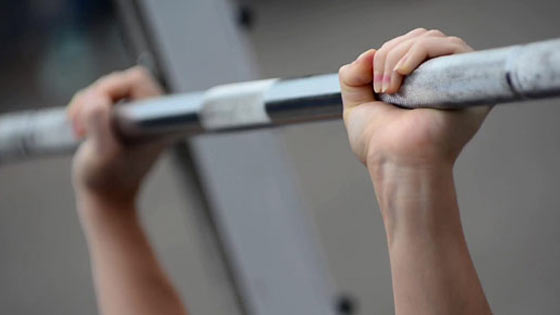
 The position of the elbows is also important in the bench press. The position with your elbows widely spaced (90 degrees) allows you to recruit the pectorals much more but can irritate your shoulders - particularly the rotator cuff tendons - and wear out your joint. Keep your elbows close to your body at about a 45-degree angle.
The position of the elbows is also important in the bench press. The position with your elbows widely spaced (90 degrees) allows you to recruit the pectorals much more but can irritate your shoulders - particularly the rotator cuff tendons - and wear out your joint. Keep your elbows close to your body at about a 45-degree angle.

Do not position your elbows at 90 degrees perpendicular to the body! This puts a lot of stress on the shoulder joint. Go for an angle of around 45 degrees…
The position with the elbows widely spaced recruits the pectorals well but can be harmful to the shoulder.
 Range of movement. It is often recommended to work with maximum amplitude during bodybuilding exercises to stretch the muscle as much as possible and promote its growth. That's true, but do you still have to touch your pectorals with the bar to do a good bench press? Reducing the amplitude is often recommended when you have long arms and a flat/narrow ribcage, to avoid overstretching the pectorals and stressing the shoulder joint. But in most cases, it often comes down to a lack of flexibility and mobility. Once sorted, this shouldn't be a problem, at least with modest loads. However, be careful if your body shape is not suitable, and limit the amplitude a little.
Range of movement. It is often recommended to work with maximum amplitude during bodybuilding exercises to stretch the muscle as much as possible and promote its growth. That's true, but do you still have to touch your pectorals with the bar to do a good bench press? Reducing the amplitude is often recommended when you have long arms and a flat/narrow ribcage, to avoid overstretching the pectorals and stressing the shoulder joint. But in most cases, it often comes down to a lack of flexibility and mobility. Once sorted, this shouldn't be a problem, at least with modest loads. However, be careful if your body shape is not suitable, and limit the amplitude a little.
 Placement of the shoulder blades. During the bench press exercise, lock the shoulder blades in a low and retracted position to stabilize the movement and better work the chest. You have to push your chest out - as you wish - and pull your shoulders down and back while squeezing your shoulder blades tightly.
Placement of the shoulder blades. During the bench press exercise, lock the shoulder blades in a low and retracted position to stabilize the movement and better work the chest. You have to push your chest out - as you wish - and pull your shoulders down and back while squeezing your shoulder blades tightly.
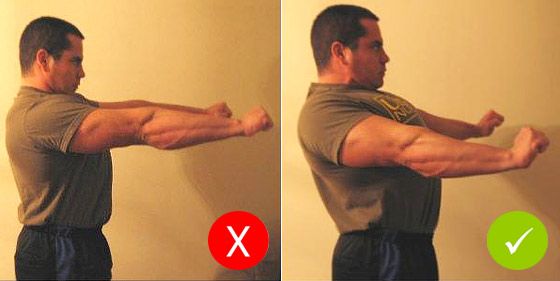
Chest and ribcage out, shoulders back and shoulder blades tight!
 For leg and foot placement. Place your feet flat, well anchored on the ground. This is the standard position, and it allows for more balance. It will then be necessary to monitor the arch of the lower back, contract the abdominals and not lift the buttocks. If you raise your buttocks during the concentric phase, you accentuate the arch of the lumbar region and create significant pressure on the vertebrae and intervertebral discs. This can lead to pinched discs and herniated discs. If you are not mobile enough, elevate your feet. Another possibility, bending your legs and placing your feet on the edge of the bench helps to limit the arching of the lower back and to have better balance. You can also bend your knees and fold your legs to keep your lower back firmly against the bench and not arch your back. This position can cause balance problems at first and is not necessarily recommended.
For leg and foot placement. Place your feet flat, well anchored on the ground. This is the standard position, and it allows for more balance. It will then be necessary to monitor the arch of the lower back, contract the abdominals and not lift the buttocks. If you raise your buttocks during the concentric phase, you accentuate the arch of the lumbar region and create significant pressure on the vertebrae and intervertebral discs. This can lead to pinched discs and herniated discs. If you are not mobile enough, elevate your feet. Another possibility, bending your legs and placing your feet on the edge of the bench helps to limit the arching of the lower back and to have better balance. You can also bend your knees and fold your legs to keep your lower back firmly against the bench and not arch your back. This position can cause balance problems at first and is not necessarily recommended.
 For gripping the bar, two possibilities. If you break the wrist, the bar is then in the palm of the hand. The thumb must be under the bar so that it rests on the axis of the forearm. If you do not break the wrist, the thumb should not be under the bar to prevent it from slipping or falling out of your hands, and to minimize tension on the wrist joint (wrist compression).
For gripping the bar, two possibilities. If you break the wrist, the bar is then in the palm of the hand. The thumb must be under the bar so that it rests on the axis of the forearm. If you do not break the wrist, the thumb should not be under the bar to prevent it from slipping or falling out of your hands, and to minimize tension on the wrist joint (wrist compression).
 If you are working with heavy loads, you need a partner to assist you because you can get trapped under the bar and seriously injure yourself. If no one can assure you, work with the dumbbells.
If you are working with heavy loads, you need a partner to assist you because you can get trapped under the bar and seriously injure yourself. If no one can assure you, work with the dumbbells.
 Lower the bar slowly without making it bounce dangerously on the rib cage. Do not change position while performing the exercise. We often see practitioners twisting themselves in two to finish their series.
Lower the bar slowly without making it bounce dangerously on the rib cage. Do not change position while performing the exercise. We often see practitioners twisting themselves in two to finish their series.
Are you made for the bench press?
Do you easily gain mass in your pectorals with the bench press? And without pain? If the answer is yes, this exercise is for you. For others, it's the shoulders and triceps that often take over. Two possibilities: either you are doing the exercise wrong, or you are simply not cut out for the bench press.
First of all, you must review the execution to properly feel the exercise, extend your chest well and position your shoulder blades correctly. Also give yourself time, especially if you're starting out, and don't go too heavy. A medium load with sets of 10 to 12 repetitions is more interesting to feel the exercise.
Anatomically , people who respond well to the bench press often have wide rib cages and collarbones, as well as short arms, while those who have narrow rib cages and collarbones, as well as very long arms, pull poorly. benefits of the exercise. In addition, they may feel pain or get injured more easily with this exercise (Source: Delavier ).
 What to do in this case? You must modify the exercise by reducing the distance between the hands on the bar and limiting the amplitude. The objective is to limit the risk of injury. To progress on the pectorals, there are many alternatives: the dumbbell press on a flat bench or decline, the machines (Smith machine) also allow better contraction of the pectorals as well as better sensations. It's up to you to test to find which variant best suits your body type.
What to do in this case? You must modify the exercise by reducing the distance between the hands on the bar and limiting the amplitude. The objective is to limit the risk of injury. To progress on the pectorals, there are many alternatives: the dumbbell press on a flat bench or decline, the machines (Smith machine) also allow better contraction of the pectorals as well as better sensations. It's up to you to test to find which variant best suits your body type.
What are the variations of bench press?
BENE PRESS WITH DUMBBELLS
The bench press with dumbbells is a more natural movement and an interesting variation which allows a gain in amplitude compared to the bar version. It allows you to properly stretch and contract the pectorals regardless of your body shape, resulting in better sensations. The exercise being more difficult to balance and involving more stabilizing muscles, you must therefore use less weight compared to the barbell press. It also allows you to go as far as muscular failure, which is not possible with the bar without a partner.
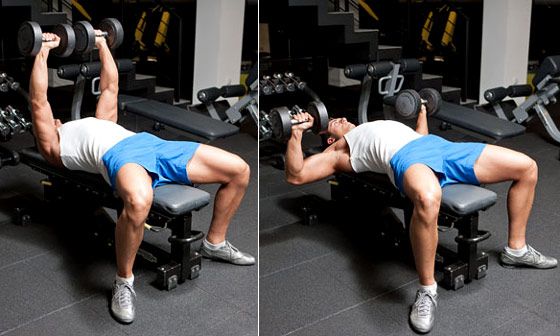
INCLINED BAR PRESS
This version allows you to work the upper part of the pectorals a little more. With an incline bench of around 30 degrees, you bring the bar towards your collarbone, trying to keep your elbows close to your body. But don't tilt too much, or your shoulders will take over too much. An exercise with the bar or dumbbells to favor if the top of your pectorals is lagging behind.
BAR DECLINED PRESS
This time, the bench is declined, that is to say inclined downwards. The objective is to better use the pectorals, especially the lower part, and to disengage the shoulders. The exercise allows you to lift good weights because the range of motion is less.

GUIDED BAR BELT PRESS
This variation of the guided machine – or Smith machine – can be interesting for beginners to understand the exercise. The frame has the advantage of making the movement safer and the exercise allows you to have good sensations in the pectorals, because you no longer need to stabilize the movement. We can then concentrate only on the pectorals. The slightly inclined version (15 to 30 degrees maximum) is particularly interesting and better adapted to the body shape. With its straight trajectory, opt for a medium width, not too wide, and be sure to keep your elbows as inward as possible.

DEVELOPED ON A CONVERGENT MACHINE
In a seated position, the machine bench press exercise stabilizes the movement and allows you to concentrate on contracting the pectorals. These guided machines allow you to work safely, alone, with heavy loads. They are not necessarily adapted to your body shape and the adjustments can sometimes be problematic, so test to confirm.
REVERSE GRIP BELT PRESS
This variation is quite difficult to master and is practiced with the hands reversed , in supination. It places emphasis on the front of the shoulders and the back of the arms (triceps) to the detriment of the pectorals. The upper pectorals are nevertheless put to work, even more if the bench is inclined. A training partner is strongly recommended to assist you. Otherwise there are seated machines that reproduce the movement.
Bench Press FAQ
IS THE BENE PRESS ESSENTIAL?
No, the bench press is not essential , far from it. This pectoral muscle exercise is really overrated in people's minds. For some, it is effective for building pectorals of steel. It still has to be used well and not overused. But for others, it's a waste of time. As we saw previously, this exercise has disadvantages and presents risks for those who do not have the right body shape.
WHAT IS THE IMPACT OF HAND SPREADING?
The classic spacing is a little wider than the shoulders, and this is the recommended one. The narrow grip works the shoulders, the inner part of the pectorals and the triceps. The wide grip covers the pectorals, especially the external part, the shoulders and a little less the triceps. The latter is not recommended. The inclination of the bench, the position of the elbows and the amplitude also have an influence on the muscles worked.
IS THE BENE PRESS THE BEST EXERCISE FOR THE PECTORS?
Some research shows it's better if your goal is to gain pecs. The 30 degree inclined press muscles the pectorals with a little extra for the clavicular portion. Although less practiced, it could be more profitable even if the weight lifted remains less important. On the other hand, tilting the bench more is not a good idea, because the front of the shoulder then takes over to the detriment of the pectorals.
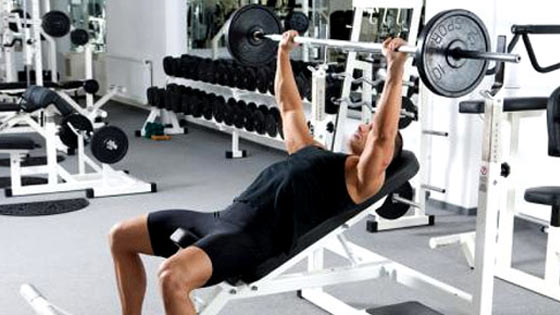
SHOULD YOU LOCK YOUR BENEFIT REPETITIONS?
Locking the elbows in the high position is not recommended. This loses tension in the pectorals and triceps which take over. Keeping the muscles under tension ( continuous tension ) allows for very intense work. Nothing beats feeling your pecs. If you watch videos of champions, you will see that they keep the muscles under tension on most exercises. In addition, this risks damaging the ligaments and tendons in the long run.
I Raise my head during the bench press, is it bad?
A study showed that when you raise your head during this exercise, you lose power and strength (around 5%). Keep your head glued to the bench.
IS BEING PRESSED WITHOUT A PARTNER RISKY?
With the bar, yes. Because you can get stuck underneath . This has happened to me several times, and rolling it up to your hips is not easy and can hurt you. Especially if the weight is heavy. It is still possible to do the exercise with dumbbells, on the guided bar or on a pectoral machine. There have been reports of deaths of exercisers stuck under a bar at home or in the gym.
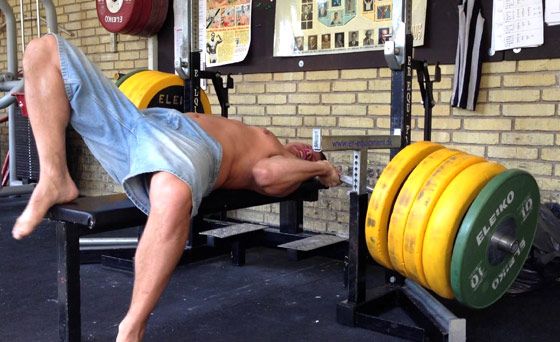
The barbell bench press requires the presence of a partner!
WHAT LOAD TO CHOOSE FOR BENEFIT?
It all depends on your level. Start with a light load and a classic format, like 4 sets of 10 repetitions. If you confirm, increase the load in the next session. The important thing is to progress from session to session. If you are aiming for muscle gain, you can do 4 x 10 at 70% of your 1RM. For strength, 5 x 5 at 85% of 1RM. If you're just starting out, don't have fun testing your maxi (1RM), it's dangerous! Use the calculation formula on this page: 1RM .
HOW TO PROGRESS ON BENE PRESS?
It all depends on the objective. Do you want to gain muscle or increase your bench press max? To progress, apply the same principles of progressive overload as for the other exercises. See: Make good progress in bodybuilding . Advanced bodybuilding practitioners can use the hardcore program to explode their bench press performance .
WHICH BAR TO USE TO DO BENEFIT?
In the gym, you will find 20 kg Olympic bars which can support a lot of weight. They have a 50 mm diameter hole and are compatible with cast iron Olympic discs. These bars are used for bodybuilding, Crossfit and weightlifting, can hold hundreds of pounds but are quite expensive. At home you can use a 1.70 m bar with the standard diameter of 28 mm to be able to add classic weight plates. If you lift heavy, always check the strength of the bar before purchasing. Otherwise it risks twisting.
.png)